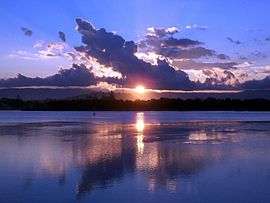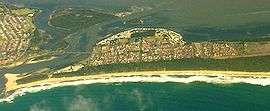Lake Illawarra
| Lake Illawarra Aboriginal (Tharawal): various adaptions of Elouera, Eloura, or Allowrie; Illa, Wurra, or Warra meaning pleasant place near the sea, or, high place near the sea, or, white clay mountain[1] | |
|---|---|
| Illawarra Lake[1] | |
|
Lake Illawarra, viewed from Sublime Point lookout, 2015. | |
 Lake Illawarra Location of Lake Illawarra in New South Wales | |
| Location | Illawarra, New South Wales |
| Coordinates | 34°31′25″S 150°50′04″E / 34.52361°S 150.83444°ECoordinates: 34°31′25″S 150°50′04″E / 34.52361°S 150.83444°E[2] |
| Type | An open and trained intermediate wave dominated barrier estuary[3] |
| Primary inflows | Macquarie Rivulet, Mullet Creek |
| Primary outflows | Tom Thumb Entrance, Tasman Sea |
| Catchment area | 238 km2 (92 sq mi) |
| Basin countries | Australia |
| Managing agency | Lake Illawarra Authority |
| Surface area | 35.8 km2 (13.8 sq mi) |
| Average depth | 2.1 metres (6 ft 11 in) |
| Water volume | 74,275 ML (2,623.0×106 cu ft) |
| Surface elevation | 0.3 metres (1 ft 0 in) AHD |
| Frozen | never |
| Settlements | Wollongong; Shellharbour |
| References | [4][5] |
Lake Illawarra (Aboriginal Tharawal language: various adaptions of Elouera, Eloura, or Allowrie; Illa, Wurra, or Warra meaning pleasant place near the sea, or, high place near the sea, or, white clay mountain[1]), an open and trained intermediate wave dominated barrier estuary[3] or large coastal lagoon,[1] is located in the Illawarra region of New South Wales, situated about 100 kilometres (62 mi) south of Sydney, Australia.
The lake environment is administered by the Lake Illawarra Authority, a New South Wales statutory authority established pursuant to the Lake Illawarra Authority Act 1987 (NSW) with the aim of transforming the degraded waters and foreshores of Lake Illawarra into an attractive recreational and tourist resource.
Location and features


Located south of the city of Wollongong, north of the city of Shellharbour, and 5 kilometres (3.1 mi) northeast of Dapto, Lake Illawarra receives runoff from the Illawarra escarpment through Macquarie Rivulet and Mullet Creek, drawing from a catchment area of 238 square kilometres (92 sq mi). With an average depth of 2.1 metres (6 ft 11 in), the relatively shallow lake, brought about because of infilling by sand which has been eroded from the surrounding catchments,[6] covers a surface area of 35.8 square kilometres (13.8 sq mi). At an elevation of 0.3 metres (1 ft 0 in) AHD , the maximum volume of water held in the lake is 74,275 megalitres (2,623.0×106 cu ft).[5]
The narrow tidal entrance to the Tasman Sea of the South Pacific Ocean is located at Windang.
Located on the western shore of Lake Illawarra at Yallah is the natural gas-powered Tallawarra Power Station. The power station draws water from the lake for cooling purposes, and returns water to the lake via an onsite water management system that ensures water quality is maintained at levels above the catchment average.[7]
The lake's location within the sprawling Wollongong urban area means that Lake Illawarra is vulnerable to pollution and urban run-off.[8][9][10][11][12][13]
Recreation
Lake Illawarra is popular for recreational fishing, prawning and sailing. On 12 January 2009, it is suspected a man was bitten by a bull shark whilst snorkelling at Windang, near the mouth of Lake Illawarra.
Birds found at the lake include pelicans, cormorants, musk ducks, hoary-headed grebes, black swans, black ducks, grey teal ducks, herons, ibises and spoonbills.
History
The traditional custodians of the land surrounding what is now known as Lake Illawarra are the Aboriginal Tharawal and Wadi Wadi peoples. Lake Illawarra was a valuable source of food and spirituality. Burial sites and middens (shell and camp rubbish heaps) discovered at Windang and surrounding areas indicate that the Wadi Wadi used the area extensively and performed various corroborees and ceremonies in the area.[14] The name Illawarra is derived from various adaptions of the Aboriginal Tharawal language words of elouera, eloura, or allowrie; illa, wurra, or warra mean generally a pleasant place near the sea, or high place near the sea, or white clay mountain.[1]
Matthew Flinders and George Bass called the lake Tom Thumb's Lagoon on Flinders' chart, named after their little boat the Tom Thumb, when they were there in March 1796.[15][14][16]
In Lake Illawarra: an ongoing history, Joseph Davis provides a wide-ranging environmental and historical biography of the lake and its foreshores. The book also contains many images and photographs depicting the lake.[17] Davis edited John Brown of Brownsville: his manuscripts, letterbook and the records of Dapto Show Society 1857-1904 that deals with the man who did most to protect the vegetation of the lake islands,[18] and he authored Gooseberry & Hooka: the island reserves of Lake Illawarra 1829-1947, the latter examining the records of John Brown and others and deals with the history of these two islands and how they survived to become nature refuges rather than recreation reserves.[19]
See also
References
- 1 2 3 4 5 "Lake Illawarra". Geographical Names Register (GNR) of NSW. Geographical Names Board of New South Wales. Retrieved 4 August 2013.
- ↑ "Lake Illawarra (NSW)". Gazetteer of Australia online. Geoscience Australia, Australian Government.
- 1 2 Roy, P.S; Williams, R.J; Jones, A.R; Yassini, I; Gibbs, P.J; Coates, B; West, R.J; Scanes, P.R; Hudson, J.P; Nichol, S (2001). "Structure and Function of South-east Australian Estuaries". Estuarine, Coastal and Shelf Science. 53 (3): 351. doi:10.1006/ecss.2001.0796.
- ↑ "Place Names Search: Lake Illawarra". Geoscience Australia. Commonwealth of Australia. 2012. Retrieved 17 May 2013.
- 1 2 "Lake Illawarra". Water: Coastal and floodplain management: Coastal zone management: Estuaries of NSW. Environment and Heritage NSW. 26 April 2012. Retrieved 17 May 2013.
- ↑ Boyd, M. J.; Morris, C. E.; Armstrong, J. (1997). "Monitoring changes in water quality in urbanising catchment". In Bouazza, Abdelmalek; Kodikara, Jayantha; Parker, Roger J. Environmental Geotechnics. Taylor & Francis. p. 233. ISBN 90-5410-903-3. Retrieved 12 January 2012.
- ↑ Mewett, Lyndsie (July–August 2009). "Tallawarra taking off in NSW". EcoGeneration. Australia. Retrieved 17 May 2013.
- ↑ Chenhall, BE; Batley, GE; Yassini, I; Depers, AM; Jones, BG (1994). "Ash distribution and metal contents of Lake Illawarra bottom sediments". Marine and Freshwater Research. 45 (6): 977. doi:10.1071/MF9940977.
- ↑ Payne, M.; Chenhall, B. E.; Murrie, M.; Jones, B. G. (1997). "Spatial Variation of Sediment-Bound Zinc, Lead, Copper and Rubidium in Lake Illawarra, a Coastal Lagoon in Eastern Australia". Journal of Coastal Research. 13 (4): 1181–91. JSTOR 4298727. INIST:2846945.
- ↑ Qu, Wenchuan; Morrison, R. J.; West, R. J. (2003). "Inorganic nutrient and oxygen fluxes across the sediment–water interface in the inshore macrophyte areas of a shallow estuary (Lake Illawarra, Australia)". Hydrobiologia. 492: 119. doi:10.1023/A:1024817912671.
- ↑ Yassini, I; Jones, BG (1987). "Ostracoda in Lake Illawarra: Environmental factors, assemblages and systematics". Marine and Freshwater Research. 38 (6): 795. doi:10.1071/MF9870795.
- ↑ Qu, Wenchuan; Morrison, R.J.; West, R.J.; Su, Chenwei (2006). "Organic matter and benthic metabolism in Lake Illawarra, Australia". Continental Shelf Research. 26 (15): 1756. doi:10.1016/j.csr.2006.05.007. INIST:18073428.
- ↑ Sloss, Craig R.; Jones, Brian G.; Murray-Wallace, Colin V.; McClennen, Charles E. (2005). "Holocene Sea Level Fluctuations and the Sedimentary Evolution of a Barrier Estuary: Lake Illawarra, New South Wales, Australia". Journal of Coastal Research. 215: 943. doi:10.2112/03-0110.1.
- 1 2 "History of Lake Illawarra". Lake Illawarra Authority. Government of New South Wales. 2010. Retrieved 17 May 2013.
- ↑ Flinders, Matthew. A Voyage to Terra Australis at Project Gutenberg
- ↑ Estensen, Miriam (2005). The Life of George Bass. Allen and Unwin. p. 53. ISBN 1-74114-130-3.
- ↑ Davis, Joseph (2005). Lake Illawarra: an ongoing history. Lake Illawarra Authority. ISBN 978-0-9757249-0-3.
- ↑ Brown, John (2011). Davis, Joseph, ed. John Brown of Brownsville: his manuscripts, letterbook and the records of Dapto Show Society 1857-1904. Lake Illawarra Authority. ISBN 978-0-9757249-3-4.
- ↑ Davis, Joseph (2011). Gooseberry & Hooka: the island reserves of Lake Illawarra 1829-1947. Lake Illawarra Authority. ISBN 978-0-9757249-4-1
External links
- "Illawarra catchments" (map). Office of Environment and Heritage. Government of New South Wales.
- Lake Illawarra Authority
- "Lake Illawarra Data Compilation and Assessment" (PDF). (4.30 MB)
